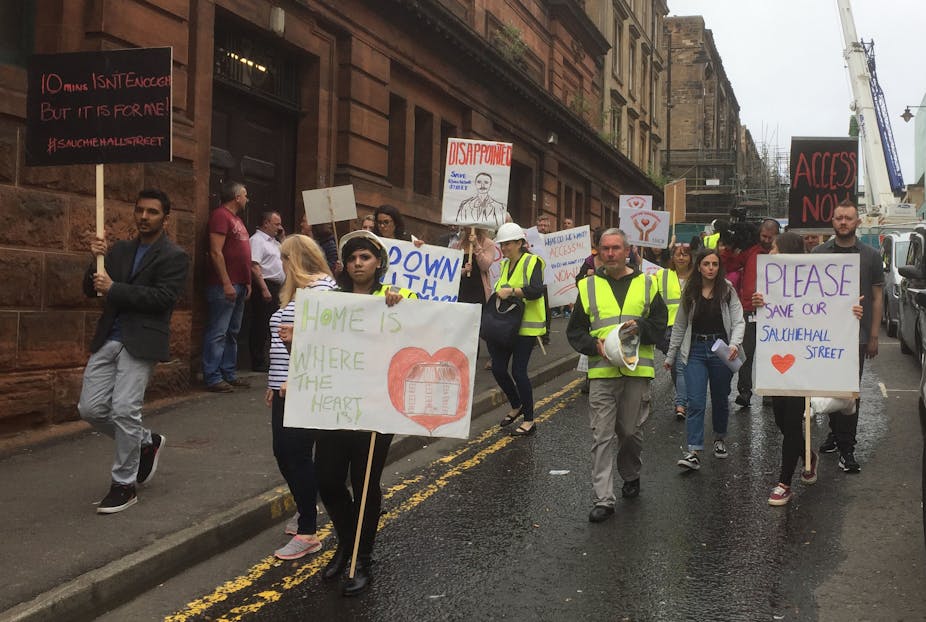When Glasgow School of Art’s Mackintosh building was devastated in June by a second fire in just four years, the distress and disbelief across the world was palpable. This time the entire building was destroyed, reducing to ashes £35m of painstaking work to repair the previous damage. But for the art school’s immediate neighbours – residents and businesses alike – the fire was just the beginning of the nightmare.
For several months, an exclusion zone has prevented 33 households and 55 businesses and their employees from returning to premises and homes. It sparked angry protests and much negative publicity, while the economic impact of excluding so many businesses will be significant. One proprietor alone on the Sauchiehall Street thoroughfare reported a £120,000 loss of income. The overall hit to business could have run to millions.
Yet all summer, the city’s authorities insisted that public safety would be compromised if restrictions were removed. Finally, the cordon has now been lifted and many are getting access after ten long weeks. But the tragedy is that they could have been accommodated much sooner if the authorities had taken a better approach to risk management. There are lessons here that authorities everywhere can learn in relation to disasters – not least those dealing with the recent fires in Rio de Janeiro and Liverpool.
Building relationships
The UK construction industry has been trying to improve its image for a number of years to make itself more modern and public-facing. In the late 1990s it introduced the Considerate Constructors Scheme, whose objectives include fostering good relationships with neighbouring residents and businesses. This has become an industry standard, celebrating the registration of its 100,000th building site in 2017. In the case of the Glasgow School of Art, however, it’s clearly mission not accomplished.
In short, a lack of cooperation and coordination between the art school and Glasgow City Council has been at the heart of the problem. The art school had hoped for the best after the fire, when it should have planned for the worst. The city council could have considered control measures to allow neighbours periodic access to premises.
In the world of health and safety risk management, conventional wisdom dictates that the best way to manage risk is to avoid it altogether. In theory, this is sound advice. Avoid risk and no further management controls are necessary; you’re no longer asking humans to manage things without causing disaster. Sorted. Or is it?
In many cases, the real reason for avoidance is a lack of resources to manage the risks properly. When you lock out residents and businesses for over two months, questions need to be asked: are the risks to public safety being avoided or managed? Could more have been done to let these people move safely in and out of the exclusion zone?
The people affected certainly think more could have been done. Besides protesting, they are now threatening legal action against the art school, the council and building contractor Kier Construction. This includes both an action for damages and for a judicial review of the risk assessment process ahead of the exclusion decision.
What should have happened
In the immediate aftermath of the fire, police allowed some residents access for a few minutes. But once the council took control of the site shortly after, it issued the exclusion using the powers over dangerous buildings laid out by Section 29 of the Building (Scotland) Act 2003.
Because of the prestige and emotional attachment to the Mackintosh, arguably Glasgow’s most important building, more has been done to avoid demolition than would usually be the case. A similar fire only a few months before saw a building demolished on a nearby shopping street, for example. In contrast, the Mackintosh has been deconstructed brick by brick. This is painstakingly slow and fraught with danger. Nonetheless, it has only been part of the problem.
The art school and council could have cooperated better to manage the risk of falling debris. They should have been quicker to design and install the facade retention to hold the outer walls in place. This is still being finished when realistically it could have been in place a month ago. The authorities could then have made it safer for members of the public to move on and off site by putting up robust netting and scaffold-built fans at high level to catch any falling objects. Netting in particular can absorb the force of falling debris very well.
At ground level, meanwhile, it is normal practice to build temporary enclosed walkways, with “crash-decks” above to protect anyone walking beneath. And where there is the risk of collapsing material rolling any distance, you can temporarily construct ballast, barriers or other retaining structures. Yet none of these things have happened.

The council could have further reduced the risks by allowing escorted access with limited “exposure time” – short periods of access during down time for contractors or during favourable conditions like low wind or dry weather. People could have been given suitable protective equipment such as hard hats to give them similar protection to construction workers on the site.
Though the risks involved are undoubtedly complex, these actions would have managed the risks adequately – especially for people who were excluded from Sauchiehall Street, which is further from immediate danger than the residential area directly above.
Those who are now being allowed to return will be delighted, but unfortunately the damage has been done. The second Glasgow School of Art fire has become a case study in how not to help neighbouring residents after a disaster. Everyone from the owners of the damaged building to the local authorities need to learn the lessons to make sure we don’t see the likes of this again.

